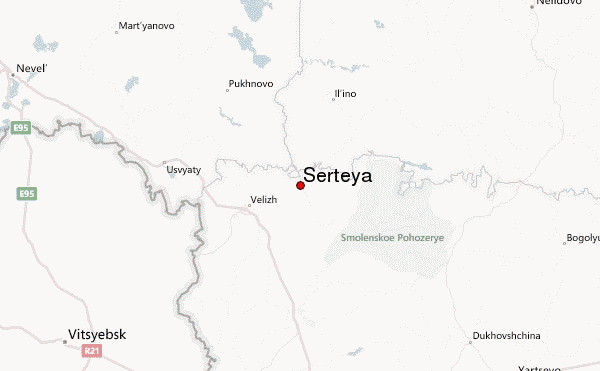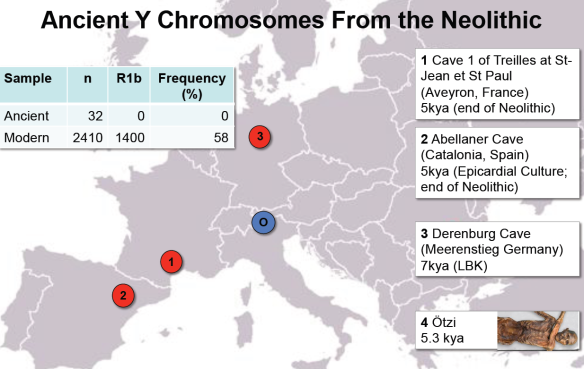Domen
Misico dux Vandalorum
A new paper on the spread of Indo-European languages in Europe has just been published:
Abstract: http://biorxiv.org/content/early/2015/02/10/013433
Here is the full paper (PDF document, 172 pages): http://biorxiv.org/content/biorxiv/early/2015/02/10/013433.full.pdf
"Massive migration from the steppe is a source for Indo-European languages in Europe":
Abstract: http://biorxiv.org/content/early/2015/02/10/013433
Here is the full paper (PDF document, 172 pages): http://biorxiv.org/content/biorxiv/early/2015/02/10/013433.full.pdf
"Massive migration from the steppe is a source for Indo-European languages in Europe":
Abstract:
We generated genome-wide data from 69 Europeans who lived between 8,000-3,000 years ago by enriching ancient DNA libraries for a target set of almost four hundred thousand polymorphisms. Enrichment of these positions decreases the sequencing required for genome-wide ancient DNA analysis by a median of around 250-fold, allowing us to study an order of magnitude more individuals than previous studies and to obtain new insights about the past. We show that the populations of western and far eastern Europe followed opposite trajectories between 8,000-5,000 years ago. At the beginning of the Neolithic period in Europe, ~8,000-7,000 years ago, closely related groups of early farmers appeared in Germany, Hungary, and Spain, different from indigenous hunter-gatherers, whereas Russia was inhabited by a distinctive population of hunter-gatherers with high affinity to a ~24,000 year old Siberian6. By ~6,000-5,000 years ago, a resurgence of hunter-gatherer ancestry had occurred throughout much of Europe, but in Russia, the Yamnaya steppe herders of this time were descended not only from the preceding eastern European hunter-gatherers, but from a population of Near Eastern ancestry. Western and Eastern Europe came into contact ~4,500 years ago, as the Late Neolithic Corded Ware people from Germany traced ~3/4 of their ancestry to the Yamnaya, documenting a massive migration into the heartland of Europe from its eastern periphery. This steppe ancestry persisted in all sampled central Europeans until at least ~3,000 years ago, and is ubiquitous in present-day Europeans. These results provide support for the theory of a steppe origin of at least some of the Indo-European languages of Europe.
(...)
Hypotheses of Indo-European origins in light of the new genetic data presented in this paper:
Genetic data is a valuable source of information that is useful for evaluating competing hypotheses of Indo-European language dispersals, to the extent that theories of such dispersals invoke migratory movements to explain their extensive distribution. Such hypotheses can be tested both with archaeology (which tests for the spread of material culture, which can spread not only by migration but also through trade or an exchange of ideas), and with genetics (which can test directly whether the movement of people accompanied perceived changes in the material record). Past genetic data from ancient DNA has confirmed one of the major predictions of the Anatolian hypothesis – the migration of early farmers from the Near East (inclusive of Anatolia) to Europe – using both mitochondrial DNA22-24 and whole genome analysis25,26. The results of our study are consistent with these findings, and also extend them by showing that not only the early farmers of central Europe (Germany and Hungary) and Scandinavia, but also of Iberia were descended from a common stock. In this sense, ancient DNA is consistent with migrations following the predictions of the Anatolian hypothesis, and indeed our ancient DNA results match the scenario outlined by Bellwood for the initial dispersal of farming into Europe remarkably well27. This is also true for the Balkan hypothesis, as geographically, southeastern Europe is a plausible place where early farmers could have diverged into an inland Danubian route toward central Europe, and a Mediterranean route toward Iberia. The evidence of a relatively homogeneous population of early European farmers with substantial Near Eastern ancestry25 is indeed a reasonable candidate for the spread of a single language family across Europe.
Our new genetic data are important in showing that a second major migration from the steppe into Europe occurred at the end of the Neolithic period (between 5000-4500 years ago). Moreover, we have demonstrated that these migrants accounted for at least ~3/4 of the ancestry of the Corded Ware people of Germany, and much of the ancestry of other Late Neolithic / Bronze Age populations of Germany and present-day northern Europeans (Fig. 3, SI9, SI10). Thus, the main argument in favor of the Anatolian hypothesis (that major language change requires major migration) can now also be applied to the Steppe hypothesis. While we cannot go back in time to learn what languages the migrants spoke, it seems more likely than not that the Corded Ware people we sampled spoke the languages of the people who contributed the great majority of their ancestry (Yamnaya), rather than the local languages of the people who preceded them. Thus, our results increase the plausibility that the Corded Ware people and those genetically similar groups who followed them in central Europe spoke a steppe-derived Indo-European language. More generally, our results level the playing field between the two leading hypotheses of Indo-European origins, as we now know that both the Early Neolithic and the Late Neolithic were associated with major migrations.
While our results do not settle the debate about the location of the proto-Indo European homeland, they increase the plausibility of some hypotheses and decrease the plausibility of others as follows:
1. The Steppe hypothesis gains in plausibility by our discovery of a migration during the Late Neolithic from the steppe into central Europe. This migration was predicted by some proponents of the Steppe hypothesis and we have now shown (definitively) that it occurred. We also note that our results help to differentiate between variants of the steppe hypothesis: we do not find evidence of an influence of steppe migrants earlier than the Corded Ware, although we cannot rule out the possibility that such evidence might be found with larger sample sizes and more sampling locations in central Europe. However, we can definitely reject that the breakup of Indo-European occurred as late as 4000 years ago28, as by ~4500 years ago the migration into Europe had already taken place. Moreover, this migration clearly resulted in a large population turnover, meaning that the Steppe hypothesis does not require elite dominance9 to have transmitted Indo-European languages into Europe. Instead, our results show that the languages could have been introduced simply by strength of numbers: via major migration in which both sexes participated (SI2, SI4)
2. The Anatolian hypothesis becomes less plausible as an explanation for the origin of all Indo-European languages in Europe, as it can no longer claim to correspond to the only major population transformation in European prehistory, and it must also account for the language of the steppe migrants. However, the Anatolian hypothesis cannot be ruled out entirely by our data, as it is possible that it still accounts for some of the major branches of the Indo-European language family in Europe, especially the branches of the south where the proportion of steppe ancestry today is smaller than in central and northern Europe (Figure 3).
3. The Balkan hypothesis faces similar difficulties as the Anatolian. If the early farmers of southeastern Europe were genetically similar to their descendants in central and western Europe, a spread of Indo-European speaking migrants from the Balkans to the rest of Europe would simply introduce another layer of “Early Neolithic” genes similar to those present elsewhere in Europe, but would not account for the migration from the steppe and its associated language. Furthermore if the steppe immigrants spoke Indo European languages, these languages are unlikely to have been acquired by migration from Europe, as our Yamnaya samples show no sign of a major component of ancestry derived from European Early or Middle Neolithic farmers (Fig. 2).
4. The Armenian plateau hypothesis gains in plausibility by the fact that we have discovered evidence of admixture in the ancestry of Yamnaya steppe pastoralists, including gene flow from a population of Near Eastern ancestry for which Armenians today appear to be a reasonable surrogate (SI4, SI7, SI9). However, the question of what languages were spoken by the “Eastern European hunter-gatherers” and the southern, Armenian-like, ancestral population remains open. Examining ancient DNA from the Caucasus and Near East may be able to provide further insight about the dynamics of the interaction between these regions and the steppe. Our results show that southern populations diluted the ancestry of populations from the steppe, but also that ancestry related to Ancient North Eurasians forms a major ancestral component of the populations of the present-day Caucasus25. Thus, both south-north and north-south genetic influence across the Caucasus is plausible.
Pitfalls in using genetic data to make inferences about language spread:
The study of Indo-European origins and language dispersals has been controversial, in part because of the history of misuse of the concept of the Proto-Indo-European homeland for ideological reasons29. In the early 20th century, Gustav Kossinna proposed the idea of ‘settlement archaeology’: that a material culture identified by archaeology, specifically the Corded Ware, might correspond to a genetically well-defined people and homogeneous language group, specifically the Proto-Indo-Europeans. Our data directly contradict Kossinna’s theories in showing that the Corded Ware are not a locally derived central European population but instead are to a significant degree descended from eastern migrants. V. Gordon Childe12, following linguistic arguments by Otto Schrader14, proposed a migration from the steppe into Europe, which seems, in view of the results of our study, to have been closer to the mark. However, following the Second World War, and especially in the 1960s and 1970s, archaeologists responded to the history of misuse of archaeology by rejecting sweeping migrations and the settlement archaeology framework altogether30, and suggesting that in practice, it would not ever be possible to show that archaeological, linguistic, and genetic groupings overlap31,32. This climate in the archaeological community has made it challenging to propose migration as an explanation for similarities or differences in material culture across time and space. Although migration is today accepted more widely by archaeologists33 than it was 30 years ago11, it is usually discussed in connection with demographic-growth models linked to the expansion of agriculture27, while migrations linked to the evolution of new socio political structures among long-established food-producing populations are less understood, less recognizable and often viewed with skepticism.
Genetic data is important to this debate as it changes the equation, bringing to bear a new type of data that can directly speak to whether or not migration occurred. This type of fact could never be clearly established before the advent of ancient DNA, except by use of stable isotope analysis which only works to detect migration if the studied samples are from the first generation of migrants. (...)












 найдена у охотника-собирателя в верховьях Западной Двины возрастом 6000 - 5000 лет назад. Сведения об этом факте опубликованы (точнее сказать -похоронены
найдена у охотника-собирателя в верховьях Западной Двины возрастом 6000 - 5000 лет назад. Сведения об этом факте опубликованы (точнее сказать -похоронены



 ).
).
 In fact, I'm left-of-center politically but try to be objective when understanding pre-history.)
In fact, I'm left-of-center politically but try to be objective when understanding pre-history.)





